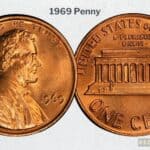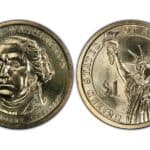The 1964 pennies are not among the rarest pennies in history. They are pretty common and easily available for less than $1 each. However, they are considered the rarest pennies in the 1960s collection of Lincoln Pennies.
Once in a while, you will come across a 1964 penny that sold for thousands of dollars at an auction but these are rare varieties of the penny.
The most valued 1964 penny is the 1964 SMS penny that once sold for $15,600 at an auction. The highest estimated value of this coin is upwards of $27,000 according to Professional Coin Grading Services (PCGS).
With that in mind, this comprehensive guide will show you the true value of different 1964 pennies and what separates them from one another.
Read on to explore every aspect of the 1964 penny, from the various varieties to the 1964 penny error lists, and what makes a 1964 penny rare!
History of the 1964 Penny
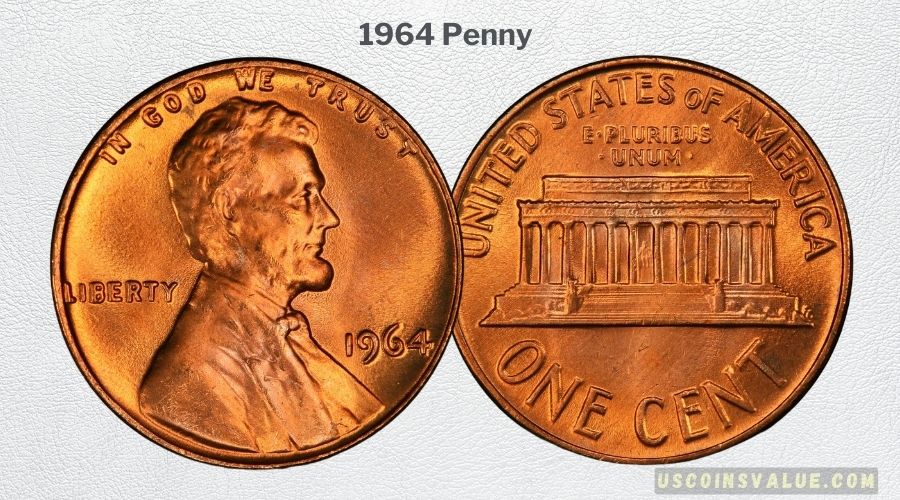
The value of any coin is attributed to its minting processes, facility, and changes during that period. For the 1964 penny, details about its history relate to the mintage and the making of the mysterious 1964 SMS pennies.
The 1909 Lincoln Memorial
The 1964 Penny is a ‘Lincoln Memorial’ penny designed by Victor D Brenner and Frank Gasparro, minted in Denver and Philadelphia.
The obverse side design was designed by Victor D Brenner and first produced in 1909 to commemorate the 100th anniversary of President Abraham Lincoln’s birth. The 1909 reverse design was also designed by Brenner and featured the iconic two-Wheat heads design.
1959 Obverse and Reverse Designs
As part of the 150th anniversary of President Abraham Lincoln’s birthday in 1959, this new series of ‘Lincoln Memorial’ pennies were introduced with the same obverse design from Brenner but a new reverse design by Frank Gasparro featuring the Lincoln Memorial instead of the 1909 Wheat heads-design.
The series design stretched from 1959 to the 2008 pennies.
1964 Mint Facilities
The pennies were made in the Denver Mint and Philadelphia Mint. Production started in Denver where the 1964 D Pennies were made (a total of 3, 799, 071, 500 coins) and later Philadelphia where the 1964 P Pennies were made (a total of 2, 648, 575, 000 coins).
1964 SMS Pennies Mystery
Nobody knows why the 1964 SMS pennies were made. Special Strike pennies were not officially scheduled for production till the 1965 coinage. 1965 to 1967 was the year the U.S. Mint made SMS coins for collectors and there was no information on the making of the 1964 SMS.
What the numismatic community knows is that these coins turned up in the estate of Former U.S. Mint Director Eva B. Adams who passed away in 1991. Some speculate they were prototypes for the 1965-1967 coinage but never authorized for public release.
The real number of 1964 SMS coins is not known but it is said to be less than 100, with rumors of around 20-50 being the agreed-upon standard.
With such low production numbers, the 1964 SMS penny is the rarest 1964 penny hence the most valuable of the bunch!
1964 Penny Features
1964 Penny Varieties
The varieties are divided based on where the coins were minted and if they are Proof or SMS coins.
Each mint location can decide to imprint a mint mark on the coin or not. In this case, the Denver (D) Mint included the ‘D’ mint mark on the coin while the Philadelphia (P) Mint did not include the ‘P’ Mint Mark, hence giving us:
- 1964 D Penny With Mint Mark
- 1964 P Penny Without Mint Mark
The above two varieties are circulated coins that make it to consumers and businesses.
Every year the Mints make coins for collectors and numismatic purposes by using high quality processes, hand crafted work, and premium procedures. They are called Proof Coins or SMS when Special Strikes are used. These coins are uncirculated.
In 1964, only the Philadelphia Mint made these coins, giving us the:
- 1964 P (Proof) Penny
- 1964 P (SMS – Special Strike) Penny
Obverse and Reverse Design Elements
The obverse side (heads) features Lincoln’s image facing the right. Inscriptions include the proclamation:
- IN GOD WE TRUST – above the image of Lincoln
- LIBERTY on the left of the image
- 1964 on the right side of image depicting the mint year
- ‘D’ Mint Mark or No Mint Mark – appears below the mint year (1964) and indicated the mint’s location: D for Denver. If there is no mint mark under the mint year then the coin was made in Philadelphia (P) which didn’t include the ‘P’ mint mark.
The reverse side depicts the Lincoln Memorial. Reverse inscriptions include:
- UNITED STATES OF AMERICA – curved above the monument
- E PLURIBUS UNUM – A motto that translates to “Out of Many, One” appears inside the concave set over the memorial by the name of the country
- ONE CENT – curved below the monument image
Design Specifications
Manufactured in Denver (D) and Philadelphia (P), the design’s melt value is $0.2 due to their high copper composition. They are heavier than today’s pennies which are a mere 2.5 grams compared to the 3.11 grams of the Lincoln pennies.
All the varieties of the coin include the following specifications:
- Composition: 95% Copper and 5% Zinc
- Face value: $0.10 – $0.30
- Weight: 3.11g
- Diameter: 19.00mm
- Thickness: 1.52mm
- Edge: Plain (no reeds)
What Makes the 1964 Penny Valuable?
Highest 1964 penny auction records:
- Circulation Strike Coins (With ‘D’ Mark): $4, 025 in 2012 – MS67 Grade
- Circulation Strike Coins (Without Mark): $7,931 in 2016 – MS67RD Grade
- Proof Coins: $2, 585 in 2017 – PR70RD Grade
- Special Strike Coins/SMS: $15,600 in 2019 – SP67RD Grade
There are several features you should care about so that you can properly evaluate the value of any 1964 coin:
1. Mint Facility, Mint Mark or No Mint Mark
The U.S. Mint came up with a Mint Mark policy that could enable collectors, coin dealers, and institutions to know where that coin was made. Essentially, a mint mark (letter(s)) would be stamped onto the coin denoting the minting facility in which the mark was used.
Mint Marks play a huge role in knowing the quality of the coin, judging its authenticity & mintmark variety, finding out the year of make, and hence its rarity.
There several mint marks used on U.S coins. The 1964 only has one type of coin with a mint mark (D) and this can add to its value as it sets it apart from the other Philadelphia Mint Coins.
If a 1964 penny has no mint mark then it can be the 1964 P Penny, the Proof penny, or a more valuable SMS variant.
2. Mintage
The lesser the number of coins out there the more valuable the coin. Mintage refers to the amount of coins that were made from any given facility.
Every year the U.S. Mints make different quantities of any given coin. Therefore coins that were produced in fewer numbers tend to be highly valued since they are rarer to find.
Since the 1964 D and P Pennies were made for circulation in the consumer market, they were produced in large numbers and hence are very common even after all these decades. 1964 Proof and SMS Pennies were not made for circulation but rather targeted to the collector and numismatic market, hence are fewer.
The number of coins made in each variety include:
- 1964 D Penny With Mint Mark made in Denver – 3, 799, 071, 500
- 1964 Penny Without Mint Mark made in Philadelphia – 2, 648, 575, 000
- 1964 Proof Penny made in Philadelphia – 3, 950, 762
- 1964 SMS – Special Strike Penny made in Philadelphia – Unknown (Estimated to be less than 50 sets by PCGS)
3. Demand
Like any other market, demand will drive the value and price of the penny. Higher demand for a certain variety means that the value will be added to the price of the coin.
A coin can be in great quality but if it is common then it won’t be as valued as a low-quality coin that is rare to find. For example, the 1964 Proof Coins are uncirculated coins in mint conditions featuring the most preserved qualities of the coin. But they are less valuable than 1964 SMS pennies which are less reflective or shiny but are rarer.
Take a look at the demand rate over time to gauge which coins are more valuable by seeing how prices change for various 1964 coins. You can look up this data in coin grading sites like the Professional Coin Grading Services (PCGS).
4. Mint Errors
Mint errors are production errors that lead to the deformation, alteration, or uniqueness of a few coins. During the minting process, the dies or minting blocks may be misaligned, damaged, misused, or changed causing the creation of coins that do not conform to the standard.
Errors on coins can significantly impact their value, and the 1964 penny is no exception. A variety of errors can be found on these coins, adding intrigue to the collecting community.
Each of these errors can elevate the value depending on the rarity, severity, and desirability among collectors.
Rare errors add more value to coins than anything else.
Major errors that are more valuable in 1964 pennies include Triple Saddle Strike and Mintage over another. More on these errors below.
3. 1964 Grading – Coin Condition & Colors
Judging a coin’s grade involves determining the coin’s condition, ranging from poor to mint state. The condition of the coin is crucial in determining its value. The most mint state coin is more valuable than a circulated coin that wasn’t preserved well.
The coin grading scale considered to be the industry standard is the Sheldon grading scale where a coin’s condition is scaled from 1 to 70. This is the scale used by notable associations like PCGS and the American Numismatic Association (ANA).
Since different varieties of coins are made each year, the scale is divided accordingly into:
- MS (60 – 70) – stands Mint State and used to show condition of circulation coins from grades 60 to 70.
- PF (60 – 70) – stands for Proof and is used to show grade of Proof coins from grades 60 t0 70.
- SP – stands for Specimen and is used to show grade of hybrid coins between Mint State and Proof.
A scale of 70 (e.g. MS70 or PF70) means that the coin has no post-production imperfections when you magnify the coin at 5x the magnification. A low grade (say MS63 or PF63) shows the coin has average strikes and weaknesses with moderate abrasions and hairlines in varying sizes.
Use a reputable coin grading guide like PCGS or consult a professional numismatist to determine the coin’s grade. The higher the grade, the more valuable the coin will be.
For 1964 circulated pennies, lower grades like MS64 and below are common hence less valuable. Higher grades above MS65 are rare and hence more valuable. For example, an MS63 1964 D penny goes for about $6, whereas the same penny with an MS67 grade goes for about $650.
The color of the coin correlates to its grade condition since a faded color shows the coin has been circulated longer and has lesser value.
Since the 1964 pennies were made mainly from copper, the color of the pennies will shift between Red and Brown depending on the level of reactions that the copper will undergo during the time it is exposed to the atmosphere.
Red (RD) means it’s a higher grade, Red-Brown (RB) is mid, and Brown (BN) or Chocolate-Brown is a lower grade coin that was mostly circulated for years.
1964 Penny Value
Below is a summary chart showcasing the different varieties of the 1964 penny and how they are valued according to PCGS.
| Grades | 1964 D Penny | 1964 P Penny | 1964 Proof Penny | 1964 SMS Penny |
| 63 | $6 | N/A | $7 | $2,650 |
| 64 | $8 | $2 | $8 | $6,000 |
| 65 | $22 | $2 | $10 | $11,500 |
| 66 | $28 | $1 | $10 | $15,000 |
| 67 | $650 | N/A | $20 | $18,500 |
| 68 | N/A | N/A | $26 | $27,500 |
Note:
- The grades (63 – 68) represents the particular coin’s grading prefix, i.e. MS63-MS68, SP63-SP68 or PF68 for Proof pennies.
- The N/A in columns without a price guide does not mean the coins are rare. Instead, it shows that there isn’t enough data to publish an average price estimate.
As you can see, the 1964 SMS penny is the most valuable of the 1964 pennies while the common 1964 D penny is the least valuable. MS63 – MS65 are the most common 1964 pennies in the market. MS66 are available but harder to find, and anything above MS67 is a needle in a haystack.
So, is the 1964 penny worth anything?
Well, if you have any 1964 SMS penny then you can make more than $2,000 even with the lowest grade conditions.
The 1964 D penny above MS66 are also valuable at more than $500. 1964 Proof pennies are less valuable at $26 in the highest-grade conditions while the P pennies are not valuable, costing at most $2 even at the best conditions.
Let’s see how each of the 1964 penny varieties are valued in auctions:
1. 1964 D Penny Value
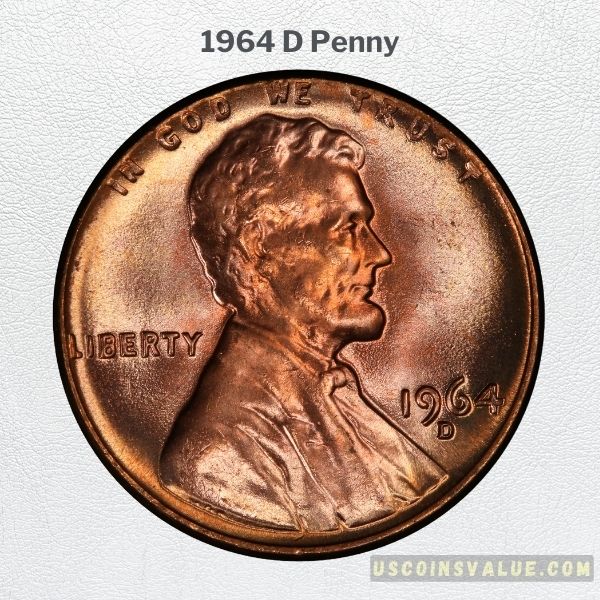
Despite the large number of 1964 D Pennies produced, the 1964 D pennies are considered one of the rarest coins in the 1960s collection since Denver Mint made very few 1964 pennies compared to the other years.
Over the following decades, the 1964 D pennies were used a lot during their circulations, leading to damages and quality decline over time. Therefore, finding any of these coins in mint condition alone will earn you a hefty buck!
Below are the highest historical auction values for the 1964 D Pennies:
| Grade | Price | Auction | Sale Date |
| MS67RD | $1,000 | Heritage Auctions | 2022 |
| MS67RD | $780 | Heritage Auctions | 2022 |
| MS67RD | $525 | Heritage Auctions | 2022 |
| MS67RD | $504 | Heritage Auctions | 2021 |
| MS67RD | $456 | Heritage Auctions | 2022 |
2. 1964 Penny Without Mint Mark
The 1964 Pennies with no mark are easily available and common up to the MS63 Grade. You can also find many outlets that stock MS64 and MS65 grades, though locating specimens might require slightly more effort, though still cheap at about less than $1 each.
The 1964 P pennies are rare once you reach MS66. Its rarity increases afterward, evident by the limited count of several thousand known instances. Upon reaching MS67, it emerges as a less common release of the 1960s, with perhaps only a few coins in existence that could attain a grade of MS67 or surpass it.
Below are the highest historical auction values for the 1964 P Pennies:
| Grade | Price | Auction | Sale Date |
| MS67RD | $1,140 | Heritage Auctions | 2019 |
| MS67RD | $850 | Heritage Auctions | 2020 |
| MS67RD | $780 | Heritage Auctions | 2020 |
| MS67RD | $720 | Heritage Auctions | 2019 |
| MS67RD | $504 | Heritage Auctions | 2020 |
3. 1964 P Penny (Proof Coins) Without Mint Mark
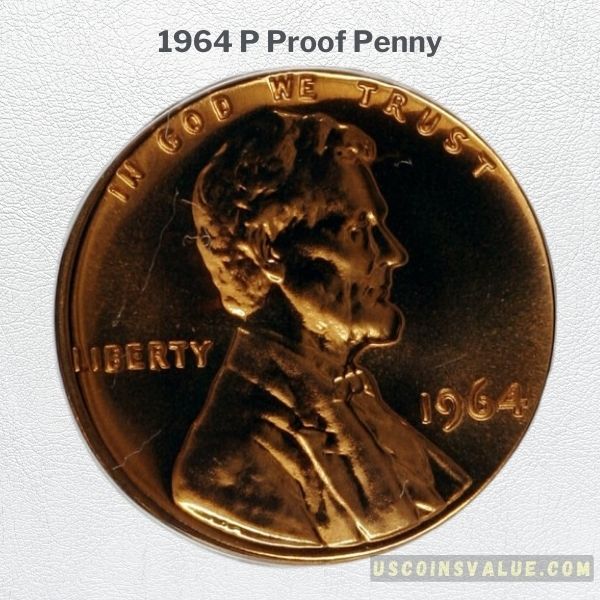
Proof coins are the highest quality of coins that the United States Mint can produce. They are status coins made for commemorative reasons and are not part of the circulated coins in the public domain. Proof coins have no blemishes and this takes a lot of work.
With that in mind, the US Mint only produces a small amount of these each year, each with its own certificate of authenticity. Once made the coins are further cleaned and polished before they are encased in a protective capsule.
This makes proof coins a targeted product for those looking for the best quality of any given penny, these include the collectors and numismatists.
Since they are rarer than the 1964 P Pennies & the 1964 D pennies, the 1964 Proof pennies are generally more valued.
Below are the highest historical auction values for the 1964 P (Proof) Pennies:
| Grade | Price | Auction | Sale Date |
| PR70 RD | $2,280 | Heritage auctions | 2021 |
| PR70 RD | $2,585 | Heritage Auctions | 2017 |
| PR70 | $1,840 | Heritage Auctions | 2008 |
| PR70 | $1,725 | Heritage Auctions | 2009 |
| PR70 | $633 | Heritage Auctions | 2004 |
4. 1964 SMS Penny (Special Strike Coins) – The Rarest 1964 Penny
The 1964 Special Strike pennies, also known as Special I Mint Sets (SMS) coins, refers to a unique subset of Lincoln Pennies minted in 1964.
These coins were struck with a special process that involved using polished dies and higher pressure compared to regular circulation strikes. However, proof coins are of higher quality than SMS coins.
SMS coins were not intended for circulation but were included in special mint sets that were sold to collectors.
Due to their limited mintage and a higher level of craftsmanship, they often command higher prices in the numismatic market compared to regular circulation-strike coins from the same year.
So, how can you tell if a penny is a 1964 SMS? Especially when it comes to 1964 SMS penny vs Regular Penny?
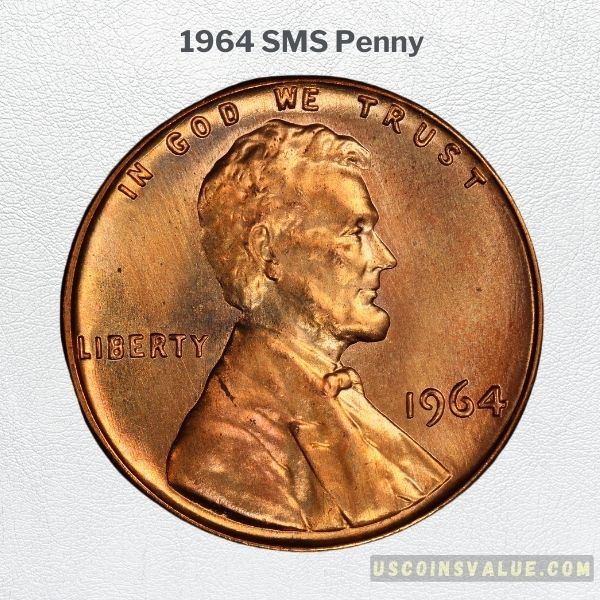
There is no inscription or stamping physical differences between the 1964 SMS pennies and the regular 1964 penny. The differences can only be seen in their finishes where the 1964 SMS variety has smoother and more detailed physical appearances.
The 1964 SMS pennies surfaces have a satin-like appearance with smooth finishes. Well-struck fields are clean, edges are sharp and squared, and there are no visible scratches or blemishes.
Below are the highest historical auction values for the 1964 P (SMS) Pennies:
| Grade | Price | Auction | Sale Date |
| SP67 RD | $15,600 | Heritage Auctions | 2019 |
| MS67 | $11,500 | Heritage Auctions | 2003 |
| SP65 RD | $11,400 | Heritage Auctions | 2019 |
| MS67 | $9775 | Heritage Auctions | 2003 |
| SP65 RD | $9,000 | Heritage Auctions | 2019 |
1964 Penny Errors
To assist collectors and enthusiasts in identifying the potential errors on their 1964 pennies, we have compiled this short list of the rarest major errors with descriptions:
1. 1964 D Penny Mintage Over Another Error
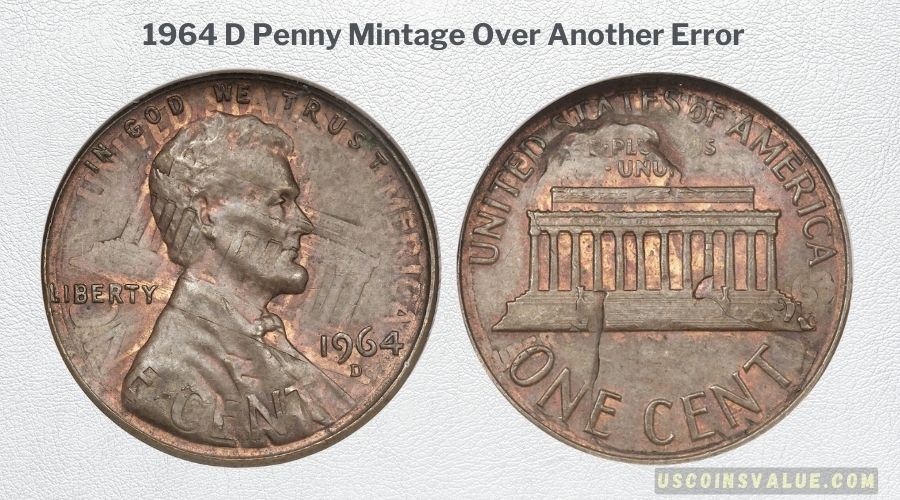
This mint error was found on an MS64 BN 1964 D Penny that sold for $4,312 in 2009 at the Heritage Auctions.
The error is a one of a kind where the reverse side of the Lincoln Memorial is imprinted on the obverse side of a coin, thereby showing both Lincoln’s image and the Lincoln Memorial on the foreground.
2. 1964 Penny Struck On A Clad Dime Planchet Error
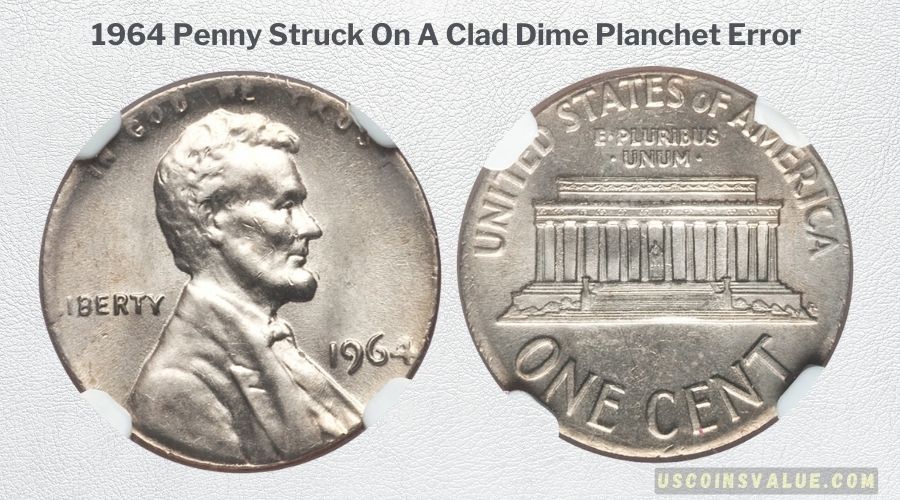
This error was found on an MS61 1964 P Penny that sold for $2, 585 in 2013 on the Heritage Auctions.
The error is classified as a transitional off metal error where a penny is made by striking on a dime planchet instead of a penny planchet. By using the wrong type of planchet which is smaller than that of a penny, the penny came out with a design that stretches and bends away towards the edges.
3. 1964 Penny Triple Saddle Strike Error
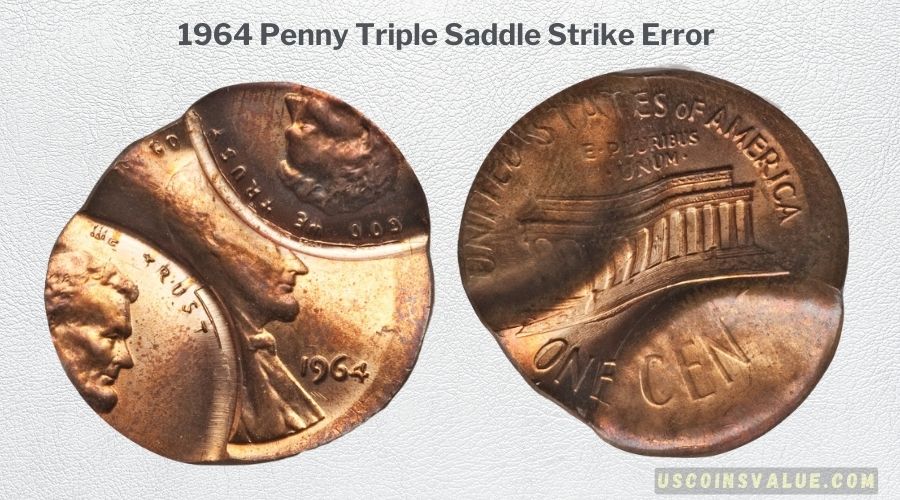
Found in the MS64 RB 1964 P Penny that sold for $1,440 in 2020 at Heritage Auctions.
The error is a unique one where the strike of making the coin struck three times thereby creating three Lincoln penny images stacked onto one coin.
Final Thoughts
Featuring the D and P varieties, SMS, and Proof Coins, 1964 pennies attract both novice enthusiasts and collectors looking for a great payday or those who just appreciate their value.
For the best value, collect high-grade varieties of the rarest 1964 penny – the 1964 SMS. The price will go even higher if the coin is Red or Red-Brown. A combination of these can earn you at least $1,300 up to a whopping $27,500. Happy collecting!

